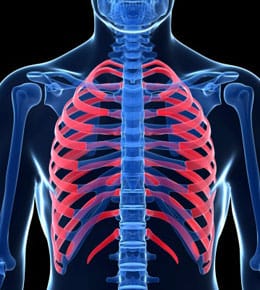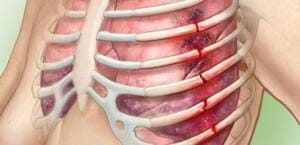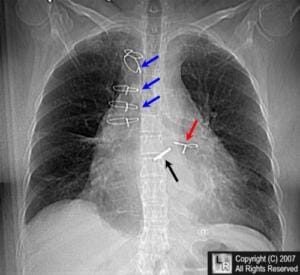Does CPR Break Ribs?

Today we are going to discuss 2 really common questions we get about CPR. The first question is ‘Does CPR break ribs?’ The second question we will also address is ‘If I break or dislocate a rib while doing CPR, can I be sued?’ We get these 2 questions in our CPR classes all the time. Today I hope to educate you a little bit about the real risks of CPR. I also hope that by the end of this post I have demystified a few common misconceptions about CPR.
Does CPR break ribs?
Yes and no.
You’ll hear instructors talking about cracking and popping sounds while doing CPR. The instructor will usually tell you that those are ribs breaking. However, that’s not always the truth. The American Heart Association says that compressions should be at a depth of 2 – 2.4 inches and done 100-120 times per minute. If you feel your own chest right now, you will notice that there actually is not a lot of depth or movement that you can get on your chest. The chest wall is not meant to move, and with the force and frequency of CPR, it can cause musculoskeletal injuries.
Usually, that cracking sound you’re hearing is actually the cartilage that connects the rib to the sternum (breast bone), and it’s being separated. Now, sometimes the actual bone of the rib will crack while doing CPR, but that’s usually related to one of two things:
- Improper hand placement generally to the left or the right of the sternum. If you’re not centered directly on the sternum, pressure from your hands can easily snap a rib or two. A South Korean study found that non-healthcare providers were more likely to break ribs. I think it’s safe to assume that it’s due to lack of experience or training.
- Age or disease. The older we get, the more brittle our bones become. Even with proper hand placement, the risk of breaking ribs during CPR increases with age. There are also bone diseases that make bones frail and easily broken even if CPR is performed correctly.
So does CPR break ribs? Sometimes. More often than not, though, it’s separation of the ribs and sternum. A study from the European Resuscitation Council found that only 1/3 of resuscitated patients had a rib fracture. Regardless, don’t let that intimidate you or deter you from doing CPR. Doing some damage to their ribs is far better than letting them die.
If you hear those cracking sounds while doing CPR, just keep pushing hard and fast on the center of the chest. There are other legitimate reason when to stop CPR, but breaking ribs is not one of them.
Should CPR Break Ribs?
I hear this less and less, but 20 years ago, it was very common for instructors to tell students “You’re not doing CPR right if you’re not breaking ribs.” That kind of teaching back then and especially today would be considered gross negligence and is a law suit waiting to happen.
Breaking ribs during CPR or separating the cartilage is NOT the sign of effective CPR. Does it happen sometimes? Yes, but instructors took it a little too far back in the day. This kind of education can lead to serious problems if your goal was to break someone’s ribs every time you did CPR.
For example, up until the age of around 10 years old, children’s bones have not fully calcified. Which means their bones have a lot more give and flexibility. If you were performing CPR on a child and were trying to compress their chest until your CPR breaks ribs, you would cause serious life-threatening injuries to their lungs, heart, and spine by compressing so hard.
Other serious concerns of truly breaking ribs during CPR is the potential for the broken rib to puncture the lung or heart. Again, this should not be a deterrent from performing CPR, but it’s a caution not to give CPR with the goal of breaking ribs.
How to Fix Broken Ribs From CPR?
Assuming all the rescuer did was separate the ribs from the sternum, the procedure to fix this is fairly simple. The correcting procedure involves a wire being used to thread the ribs back onto the sternum. You then allow the ribs time to heal. Obviously, the chest is going to be sore for several weeks, but it’s a minor consequence considering the alternative.
Can I Be Sued if CPR Break Ribs?
No. The Good Samaritan laws in your state do cover you.
You are doing your best to save that person’s life. The courts recognizes this. You may still be sued by the family or patient. However, these cases do not hold up in court because of the Good Samaritan laws.
These laws are setup to protect you in the event that you performed CPR according to national guidelines. It does not cover gross negligence or skills outside the scope of what is taught in a CPR and First Aid class. Here are two examples of what I mean by this.
- Performing CPR with the intent of trying to break ribs, or placing your hands during compressions over the victim’s breast or abdomen, instead of on their breast bone.
- Trying to do an advanced procedure not covered in a basic CPR class such as trying to make an airway in the victim’s throat with a pen.
These are examples of gross negligence that if the court had reason to believe you acted in such a manner, you would no longer receive the protection of the Good Samaritan law.
I hope this article helped answer all your questions about if CPR breaks ribs. We’d love to hear your thoughts or questions in the comments below, and we always will respond back. You can check out other lesser known facts about CPR that you may not have heard in your previous CPR classes, even if you took the more advanced BLS for Healthcare Providers class.
Vitali provides life-saving training taught by real emergency responders. You can view our current locations where we have regularly scheduled classes, or request for us to do on-site training at your location.



